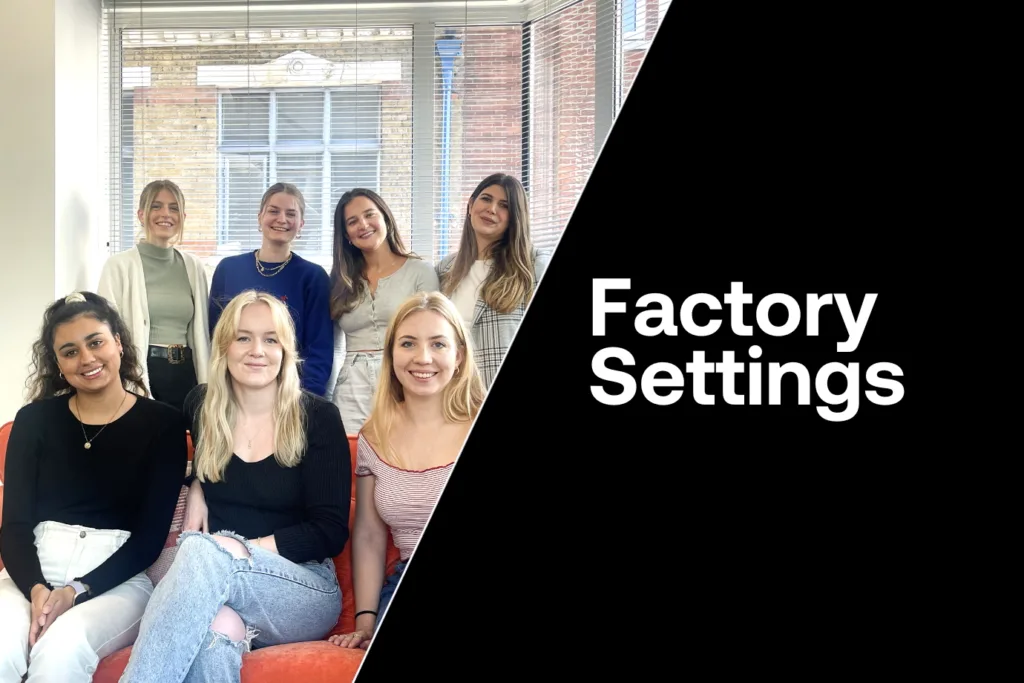How the post-Covid working environment empowered a new generation of digital professionals
By Camilla Hay, Senior Digital Account Executive at The Kite Factory
In the second part of our Factory Settings series finale, I continue my conversation with the female members of The Kite Factory digital department.
Iona Bogle and Annie Crook (both Senior Digital Account Executives) started at TKF after we had already transitioned to hybrid working, but how was the experience for them, and were there any surprised – good or bad?
Annie recounted that when she began at the beginning of 2022, the thought of hybrid working was much more daunting than reality. Initially, she had imagined that support would be harder to obtain; however, when it came to it, TKF was a lot more set up for remote working than she had expected.
Iona started in the summer of 2021 when there was no obligation to be in on any day at all. So, on her first day, there was almost nobody in the office. However, this meant it was a lot less overwhelming and gave her a chance to settle in with just her manager and a couple of other people. It was the following day, when she had set up to work from home that it all felt a bit weird.
Both Iona and Annie raised that in previous circumstances when starting a new role, you could simply tap someone on the shoulder when you need to ask a question. They emphasised how important it is not to feel like a nuisance and to send those small questions over Teams or even ask if you can jump on a quick call. It’s an important way to learn. Being entry-level can make it even harder as you have little context not only of the work itself, but also of factors such as technology.
They recounted that there are numerous pros to starting a role in a hybrid setting. Whilst if you’re an extrovert starting in a busy office might be beneficial. If you’re an introvert, starting in a hybrid setting can be great as you can get to grips with the processes and people instead of having an overwhelming experience. Long commutes when first starting can also be incredibly tiring, so being able to just go in a couple of days a week enables you to portray your personality without being too drained initially
On the flip-side, Annie raised some challenges with starting as an entry-level remote. You miss out on that overarching context where you can pick things up from other teams discussing topics in the office that might be useful to you. You definitely have to be more proactive and put yourself out there to learn.
We then opened the floor to a discussion about whether hybrid working is here to stay and what tips we had, for now, starters and also longer term.
Iona highlighted the importance of jumping on a call with someone to ask those key questions or sending them a message where you would have previously tapped them on the shoulder.
I recommended joining as many training sessions and focus groups as possible. This allows you to meet people from other teams you wouldn’t otherwise meet remotely. In turn, this is great to help with building your profile.
Annie said about picking and choosing days when you come into the office versus not. For example, if you have fewer independent tasks, this can be a great opportunity to come into the office and join lots of face-to-face learning sessions. Alternatively, if you have many big tasks to focus on, you might prefer to stay home. Noora Valtonen, Digital Planner Buyer, agreed that she benefits from coming into the office when she needs energy from other people. Immy, on the other hand, spoke about preferring to go into the office on a Monday when it’s quiet. Mondays can often be overwhelming with the week ahead to plan, and she finds it great to manage her workload for the rest of the week whilst being able to leave at 5:30 and have a mental cut-off.
Finally, we discussed what work will look like in the next five years.
I discussed not being able to imagine somewhere like TKF ever having more than three days a week compulsory. People know there are many benefits of allowing people to work from home on some days. I think there might be more of a move towards hot desking at other offices. Pre-Covid, my team spent a full day at one of our client’s offices every two weeks. Because everyone is hybrid working, it’s hard to get days to align. However, this will become something that is built into the working week.
Claudia confirmed she believes hybrid working is here to stay and that there are also economic benefits. It provides families with an opportunity to spend more time with their children. In terms of those economic benefits, Noora recounted that lots of offices have now downsized, and if everyone had to come into the office five days a week, there wouldn’t be the capacity. It, therefore, makes sense for the business as they don’t have to upgrade their offices.
The question of a four-day working week then came up. Of course, initially, this sounds like a lovely idea. However, we identified issues with this, such as whether it would mean working very long hours on those four days and not being able to do anything with your evenings. We also work with many different sectors, and if they weren’t doing four-day weeks, what would this mean for them? Iona suggested that a nine-day fortnight could help with the work-life balance whilst the business doesn’t have to shut down as half of a client patch would work one Friday, whilst the other work the other so that clients are never without a key point of contact. Annie recalled hearing that this method does actually increase productivity, according to studies.
Ultimately, through this discussion, we could discuss ways the shifting working environment in the post-Covid era has positively impacted us. We feel confident that this has helped us as the younger generation of digital advertising professionals to develop in ways which will help us to stand out in the years to come.










